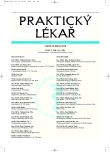Emergency resuscitation in the front line
Authors:
J. Pokorný Jr.; V. Mareček; J. Dizon; J. Růžička; R. Červený; V. Di Cara
Published in:
Prakt. Lék. 2006; 86(9): 491-493
Category:
Reviews
Overview
The article outlines the activities of the European Resuscitation Council, which are being gradually introduced in the Czech Republic through the Czech Resuscitation Council. It acquaints health professionals with the steps and aims of basic life support (BLS), advanced life support (ALS), and paediatric life support (EPLS). It details the skills that every health professional is expected to have (checking the airway is open, clearing the airway of the victim’s tongue or other visible obstruction, bag-mask ventilation, oral or nasal intubation, chest compression techniques, use of an automatic external defibrillator (AED), securing peripheral venous access). The possibilities of teamwork during resuscitation are further discussed. The guidelines for basic life support may be carried out successfully by one rescuer; however, to prevent fatigue – especially whilst performing chest compression – it is advantageous if more than one rescuer is present so that they can take it turns. For the majority of patients with acute cardiac arrest, survival is dependent upon the first few minutes in the stage termed “the front line”. With this in mind, the authors recommend that more attention be given to theoretical and practical training for health professionals in the front line than is currently the case.
Key words:
emergency resuscitation, basic and advanced life support, clearing airways, defibrillation, team work, Czech Resuscitation Council
Labels
General practitioner for children and adolescents General practitioner for adultsArticle was published in
General Practitioner

2006 Issue 9
Most read in this issue
- Tandem Heart used for treatment of the most severe forms of heart failure – left ventricular support
- Oral anticoagulant therapy
- Epiglotitis – The Experience with patients hospitalized in RES FN Motol
- Non-setroidal anti-inflammatory drugs – use in treatment of cardiovascular disease an cardiovascular risks
